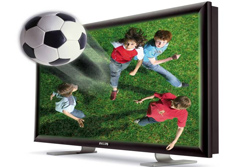Europe's online source of news, data & analysis for professionals involved in packaged media and new delivery technologies

With unified standard 3D TVs could account for 16% of TV sales by 2015
As more 3D movies are released in the cinema, technology is arriving that will allow viewers to enjoy the same experience from the comfort of their own sofa. At present the most reliable technology will require consumers to invest in a new TV and wear special 3D glasses, but Screen Digest believes that autostereoscopic technology will eventually become most popular as it has one major advantage: no glasses.
This is a market in its infancy and that mass uptake is a long way off. Screen Digest has identified two scenarios for the evolution of the market. Should a unifying standard emerge that works across all technologies, the percentage of TVs sold with 3D capability would exceed 10% worldwide in only three years (2011) and by 2015 would account for 16% of TV sales, with just over 2.8bn units sold worldwide. Without a standard, this figure drops to only 3% by 2015 or 500m units.
As 3D requires twice the broadcast bandwidth of today's two-dimensional viewing experience, the UK market researchers expect Blu-ray Disc to provide the main method of distribution, as its hi-def content capacity bypasses the bandwidth issue altogether.
With Screen Digest analysis revealing a significant premium of up to 50% on cinema tickets for 3D movies, the Hollywood Studios have a vested interest in getting 3D entertainment into homes.
Keen to avoid a costly replay of the hi-def disc format war, industry associations are already working together to establish a viable roadmap to make that happen. But due to higher bandwidth and incremental production costs, when it does come to the small screen, 3D TV programming will be the reserve of paying customers only.
3D movie production has increased rapidly. In 2008, there were seven films; in 2009 there will be 17 and a further 28 are due to be released in 2010. Compared with live action, animated films are much easier to adapt to 3D, and Disney and DreamWorks Animation have been quick to grasp the opportunity. Together they account for more than half of the 3D film release slate. It is more challenging to produce 3D TV programming on broadcasting budgets, yet nonetheless several broadcasters have launched trials around sporting events.
Screen Digest believes that ultimately it may be 3D games and not movies or TV that arrives in the home first. Gaming is an early adopter market, consoles and software could be upgraded relatively painlessly and gamers are more willing to adopt peripherals such as glasses, all of which make it an ideal home entry point for 3D technology.
"What 3D offers the Studios and pay TV operators an opportunity to charge a premium for content – perhaps even more so than high definition," says Marie Bloomfield, Analyst at Screen Digest. "But as it is emerging in the middle of a recession, the home 3D market is in a Catch 22 situation. Consumers will not be persuaded to invest in new equipment to experience 3D until there is enough content; and content production will not ramp up until there is a significant audience. 3D in the home will therefore be a slow burn, remaining a niche business for the foreseeable future."
Story filed 03.04.09



















